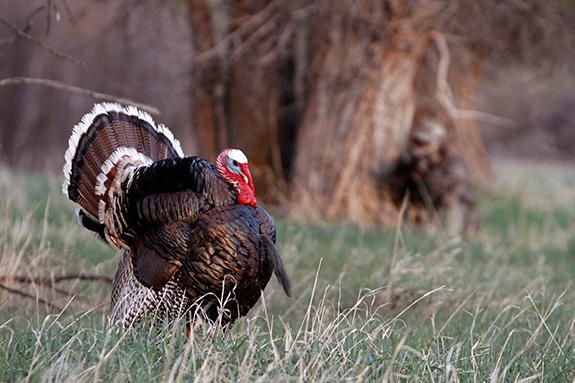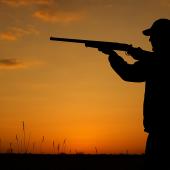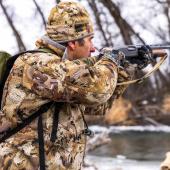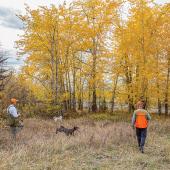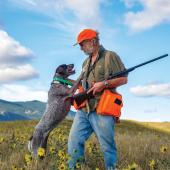Turkey Time
Hunting Montana's most festive bird.
As dawn broke on an April morning, the sounds of courting snipe and northbound geese filled the sky, and pasque flowers appeared along the old snow. Somehow, we had all survived another winter.
I hiked a mile of pines before I heard what I really came to hear—the haunting gobble of a wild turkey, a sound as surreal as an elk’s bugle. On a calm morning one can carry for miles, so I hustled to reach the tom before he left his roost and joined his hens. Better an hour early than a minute late. No matter what the outcome of the encounter ahead, I was already thanking the bird for inviting me back to the woods.
Habitat
The journals of Lewis & Clark don’t mention wild turkeys as they crossed Montana, because there weren’t any. Adapted to milder climates, they couldn’t survive our winters until agriculture provided them feedlots to help them outlast the snow. Now wild turkeys, representing five subspecies, inhabit every state except Alaska. Most Montana birds are Merriam’s turkeys living east of the Continental Divide, although populations of Easterns have become established farther west.
Turkeys need roost trees. Typical Montana habitat consists of timbered ridges interspersed with meadows, or river-bottoms containing cottonwoods. While it’s common to observe turkeys in barnyards and feedlots during winter, they’re likely to be dispersed by the time the season opens in early April. Southeastern Montana is prime turkey country; they are also well-established in parts of Region 4 and the Missouri Breaks. In Region 3, river bottoms are your best bet. Turkey numbers fluctuate considerably from year to year depending on weather during the previous spring, so discussion with an FWP biologist is wise.
Behavior
In the spring, turkeys often follow the receding snowline uphill in search of food. They form loose flocks consisting of a dominant gobbler, a dozen or more hens, and a variable number of “satellite” gobblers. They often call vigorously from their roost trees before flying down around first light. Turkeys have poor night vision, so hunters should try to get as close as possible undetected and set up before “fly down.” Naturally, hens move toward gobbler calls rather than the other way around. A gobbler’s response to calling can vary from ignoring it to approaching on a run. The more hens near the gobbler, the less likely an immediate response. Be patient, since a gobbler will sometimes return hours later.
Gear
Calling is the essence of spring turkey hunting, and reams have been written about the subject. My advice is twofold: keep it simple and avoid over-calling. Calls come in a variety of forms including box calls (the easiest to master), slates, and mouth diaphragms (which are harder to use but leave the hunter’s hands free). All are effective given the right bird and the right situation. Learn one and stick to it. Most turkey calls are meant to imitate hens, including a variety of yelps, purrs, cackles, and cuts. At first, learn the yelp and don’t worry about the rest. Avoid imitating a gobble, which is more likely to call in turkey hunters than turkeys.
Concealment is the second key to successful turkey hunting. Turkeys have remarkable vision and are especially adept at detecting movement. If you can’t sit still, you’re not going to call in many turkeys. Gobblers are also good pattern recognizers, so camouflage is important. Be sure to conceal your hands and face.
I hunt turkeys with a bow now, so I have to disguise the motion of the draw. I carry lightweight netting in my pack and stretch it across a fallen tree before calling from behind it. This tactic can be valuable for shotgun hunters as well. While I do most of my bird shooting with a 20-gauge, turkeys are an exception. Shoot a full choke 12-gauge and size 2 shot or BBs. Call the bird in close and aim for the head and neck. Bows can be very effective on turkeys, but don’t underestimate the birds’ toughness. I hunt with the same tackle I use for deer and elk.
Regs
Montana offers both spring and fall turkey seasons, with dates and limits varying by region. In the fall, turkeys are largely targets of opportunity for hunters pursuing other game. Real turkey hunting takes place in the spring, when wary males (“toms” or “gobblers”) can be called in to close range.
I didn’t kill the tom I heard that opening morning. Although he was steadily approaching, a real hen lured him away before he reached bow range. However, he kept me challenged and entertained for hours, and his wariness left me with what I really wanted most from the morning: an excuse to go back out again.
E. Donnall Thomas Jr. has lived and hunted in Montana for over 40 years.


